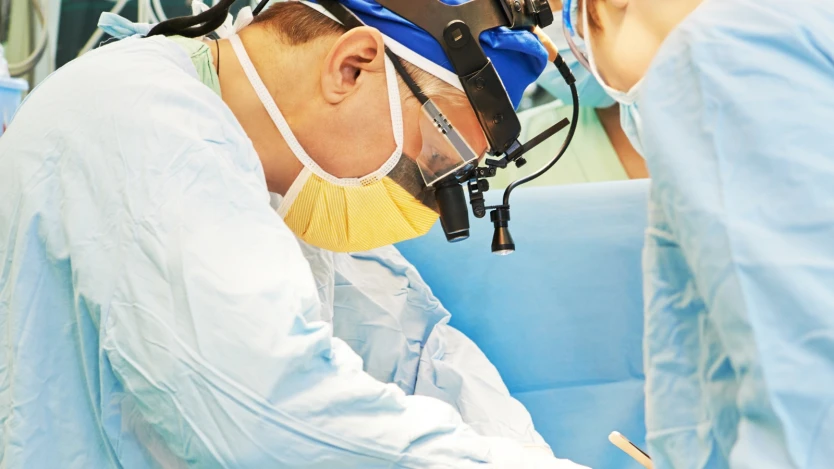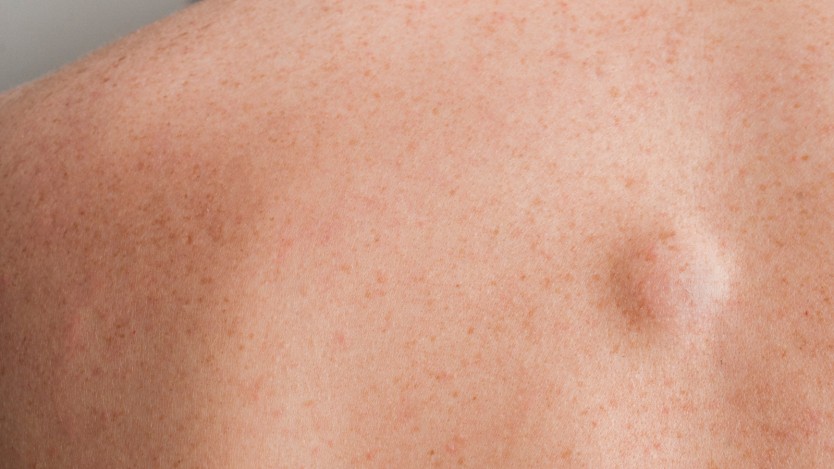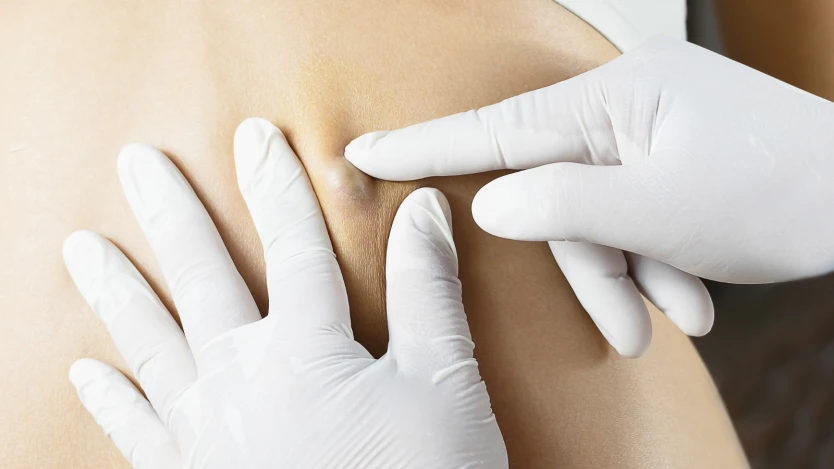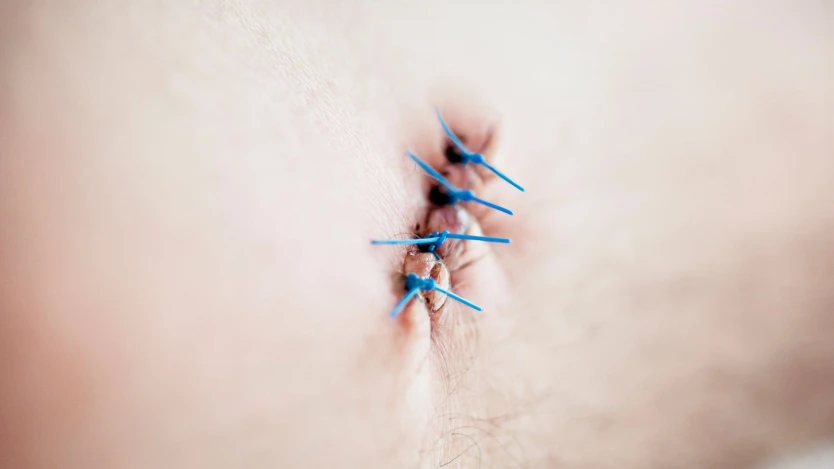Lipomas on the back: types, diagnosis, surgery and complications

- What are lipomas?
- Diagnosis of back lipomas
- Indications and contraindications for back lipoma surgery
- Treatment for lipomas on the back
- Back lipomas surgery: step by step
- Postoperative complications of back lipomas
- Recovery of back lipomas
- Request a surgical consultation with Operarme
- Lipomas on the back grow gradually over time and can reach a size of around 10 cm in diameter.
- The only way to remove lipomas on the back is surgery.
- The likelihood of postoperative complications following the removal of lipomas on the back is low.
What are lipomas?
Lipomas are the most common benign tumours of the soft tissues of the human body. They are made up of adipose tissue cells. Lipomas are usually identified and present clinically as subcutaneous nodular lesions, i.e. under the skin, located predominantly on the trunk, neck and back.

Do you need surgery to remove a lipoma on the back?
Request a free and immediate appointment with our specialists in general surgery
Lipomas on the back and in any other location are nodular lesions that are characterised by being soft to the touch, rounded or in the form of several lobulations and are not usually attached to deep planes and are therefore movable when the patient touches them. Depending on their size, they may be more or less prominent and visible to the naked eye and are usually covered by normal-looking skin.
Lipomas on the back
Lipomas on the back are usually of the subcutaneous type. They are usually benign tumours that progressively increase in size.
Like most types of lipomas, those present on the back do not usually show specific symptoms except for intermittent episodes of pain and inflammation, produced in most cases by repetitive microtrauma in the area where they are located.

On the other hand, it is possible, at certain times, that lipomas may become infected, leading to an increase in size and reddening of the surrounding skin. On these occasions, antibiotics may be necessary to control the infection.
Lipomas are usually more evident between the ages of 40 and 60.
Lipomas on the back grow slowly to between 2 cm and 10 cm in diameter and then remain stable. Although they can sometimes cause local discomfort, they are usually asymptomatic.
In 6-7% of cases, lipomas are multiple and can be very numerous. When they are very numerous, we speak of lipomatosis. Lipomatosis can be hereditary, such as familial multiple lipomatosis, or acquired.

Types of lipomas on the back
With regard to the type of lipomas based on their shape and internal characteristics, lipomas can be:
- Fibrolipomas: this type of lipoma is characterised by the presence of adipose tissue cells and fibrous, hard tissue cells.
- Myxolipomas: these are lipomas in which a particular internal change called myxoid occurs. This type of alteration causes changes in the normal cells that make up the lipoma due to an accumulation of substances called mucopolysaccharides.
- Chondroid lipoma: a recently described type of lipoma characterised by the formation of cells similar to those found in the cartilage covering certain joints in the human body.
- Myolipoma: this type of lipoma is characterised by a mixture of adipose or fatty tissue cells and muscle cells. There are many different types of myolipoma depending on the proportion between the two cells.
- Spindle cell lipoma: these are a specific type of lipoma that is preferentially located in the neck, back and shoulders of young adults. They contain a mixture of adipose and fibrous cells with similar characteristics to fibrolipoma.
- Angiomyolipoma: this type of lipoma is characterised by the appearance of a certain vascular component (blood vessels) forming part of the lipoma itself. They usually appear during adolescence and are most frequently located on the lower limbs and trunk and are characterised by the appearance of intermittent pain related to the amount of vascularisation present.
- Lipoblastoma: Type of lipoma formed by embryonic cells of adipose tissue and which is mainly characterised by its appearance at an early age and almost exclusively in the upper portions of the lower and upper limbs.
- Hibernoma: a rare benign tumour that is mainly located in the axilla and intracapsular regions, is typically brown in colour and consists of brown adipose tissue.
Diagnosis of back lipomas
The diagnosis of lipomas on the back begins in a large percentage of cases with self-examination by the patient.
It is usually the patient himself who becomes aware of the enlargement of the lipoma and consults his primary care physician. Inspection of the lesion together with palpation is usually sufficient to make a definitive diagnosis.
On certain occasions it may be difficult to differentiate the characteristics of lipoma simply by examination and inspection. On these occasions, it may be necessary to perform a biopsy of the lesion and subsequent pathological analysis.
In those cases where the true size of the lipoma on the back or its depth cannot be determined by inspection and palpation, ultrasound may be necessary to provide new insights and data to assure the specialist of the correct arrangement of the lipoma and its relationship to adjacent anatomical structures. This is not usually necessary in most cases.
Indications and contraindications for back lipoma surgery
Surgery for lipomas on the back must comply with a series of indications in order to consider the possibility of surgical removal.
When to operate on a lipoma on the back?
The main indications are aesthetic reasons, the appearance of pain on a regular basis, recurrent infections of the lipoma and, in general, those lipomas smaller than 20 centimetres.
The maximum size at which lipomas can be removed by a minor surgical technique is 5 cm.
When is it not advisable to perform surgery on a back lipoma?
On the contrary, the main contraindications for surgical removal of lipomas are their large size and their location in certain areas of the human body that compromise other functions or that, due to subsequent scarring, may interfere with the mobility of certain regions of the human body.
Treatment for lipomas on the back
The definitive treatment for lipomas on the back or in any other location is the lipoma removal surgery. This is the only therapeutic measure that ensures the complete elimination of the lipoma.

To do this, the patient should consult their primary care physician who is in charge of the minor surgery consultation or the surgeon who will perform the surgical removal of the lipoma.
As this is a surgical procedure, the patient may be required to undergo certain exploratory tests as part of a basic preoperative work-up. However, if the lesions are small in size, this will probably not be necessary.

Do you need surgery to remove a lipoma on the back?
Request a free and immediate appointment with our specialists in general surgery
On the day of the surgery, the patient will go to the indicated hospital/clinic and will be accompanied to the operating theatre for the surgery. Once changed and dressed in the appropriate surgical clothing, the patient will be placed in the most suitable position for the start of the operation.
In the case of lipomas on the back, it is usually necessary to be positioned in the prone position with the arms extended (face down on the stretcher). From this moment on, and taking into account the size of the lipoma on the back, local anaesthesia is administered around the lipoma to ensure the comfort of the patient and the specialist performing the intervention, as well as to make the procedure as painless as possible.
Back lipomas surgery: step by step
The usual procedure for the surgical removal of a lipoma on the back is usually by performing a fusiform excision, thereby achieving a simple and aesthetic primary closure (a straight scar).
The steps to follow during this surgery are:
- To achieve greater precision when performing this procedure, the spindle or buttonhole to be made around the lipoma should be drawn in the shape of an ellipse. Once drawn, the surgical buttonhole is cut. This operation is performed with small scalpel blades.
- Next, after cutting the skin, the adhesions are separated from the base of the skin piece. This operation is performed with scissors or a scalpel, while pulling on one end of the spindle with forceps or a mosquito, without damaging the lesion.
- After separation of the adhesions, the lipoma on the back is dissected. Once the lesion has been removed, the incision is closed with a non-absorbable suture and, if necessary, an absorbable suture is also used.
Lipoma removal is performed under local anaesthesia.

Postoperative complications of back lipomas
Lipomas on the back, as well as other lipomas, can present a series of complications after the operation, although they are rare.
To avoid the majority of postoperative complications of a lipoma, the most advisable thing to do is to thoroughly clean and heal the wound.
Lipomas removed from the back are usually the ones that present the most complications of a mechanical and infectious nature, and are generally very minor and infrequent.
Below we explain the most common complications of lipomas on the back:
- Suture dehiscence (reopening of the wound): this is the separation of the edges before the healing process. It may be related to premature mobilisation of the operated area. Re-suturing is often not possible and the wound has to be left to heal by secondary intention.
- Wound bleeding: usually subsides with compression and appropriate bandaging.
- Seromas and haematomas: will require evacuation and placement of drains, compression and daily dressings.
- Infections: redness of the wound edges greater than 0.5 cm occurs. If pus appears, infection is certain. It will be necessary to remove the necessary stitches, disinfect the wound and perform daily dressings. An antibiotic should be added.
- Granulomas: hard tumours that appear in the suture, differentiated from the surrounding tissue. Their tendency is towards healing or suppuration, acting accordingly.
- Pigmentation of the scar: this usually occurs in areas exposed to the sun. It can be prevented by recommending the use of creams with a high sun protection factor, up to six months after the operation.
- Hypertrophic and keloid scars: these do not depend on the technique but on the patient himself. Their treatment is complex and, on many occasions, with poor results.

Do you need surgery to remove a lipoma on the back?
Request a free and immediate appointment with our specialists in general surgery
Recovery of back lipomas
After the surgery for the removal of lipomas on the back, a series of recommendations are usually necessary for the patient to take full care of the surgical scar at home.
The good application of home care of the wound will be fundamental for the good evolution of the same and the best possible aesthetic result. With regard to wound care, the most important guidelines to bear in mind are:
- Large lipomas: removal of the dressing every 24 hours and treatment with disinfectants such as iodine to minimise the chance of secondary infection of the surgical wound.
In small lipomas it is possible not to occlude the wound with a dressing, but it requires more frequent dressings.
- Small lipomas: in these cases, wound care with disinfectants and cleaning of the area must be much stricter than in covered wounds.
- Occlusion with dressings, cleaning and daily wound care: in the case of lipomas on the back, being an area of high tissue traction and an area of significant sweating, it is essential to maintain a thorough hygiene of the area.
- The more you reduce movement in the wound area, the better the wound will heal.
It is possible that in the days following the operation, in the first 24 to 48 hours, you may experience small episodes of pain in the surgical wound. Mild painkillers such as paracetamol can be used to control them.

Surgical wounds must be subjected to special care with regard to exposure to solar radiation. In the initial stage of healing, sun exposure can chronically darken the surgical wound. It is recommended to cover the wound for the next 6 months and to apply full sun protection factor at times of increased exposure to sunlight.
Most stitches are removed within 4 to 21 days depending on the site of the procedure and how quickly the wound heals.
During the days following surgery it is very important to observe and recognise the signs and symptoms of early infection. The main signs and symptoms are
- Redness at the periphery of the scar.
- Outpouring of purulent fluid.
- Increased size of the surgical wound.
- Appearance of warmth on palpation.
If one or more of these symptoms are observed, the patient should be assessed by the specialist who performed the operation. In some cases, antibiotic treatment may be necessary for a few days.
Request a surgical consultation with Operarme
If you are thinking of solving the problems caused by the appearance of one or more lipomas on your back with surgery through Operarme, remember that you can request a free, immediate surgical assessment consultation with our general surgeons by calling at +34 91 141 33 56; by filling in the contact form or by clicking below:

Do you need surgery to remove a lipoma on the back?
Request a free and immediate appointment with our specialists in general surgery
Medical disclaimer: All the published content in Operarme is intended to disseminate reliable medical information to the general public, and is reviewed by healthcare professionals. In any case should this information be used to perform a diagnosis, indicate a treatment, or replace the medical assessment of a professional in a face to face consultation. Find more information in the links below:
